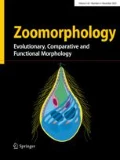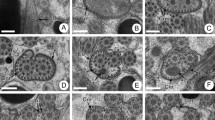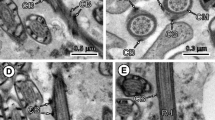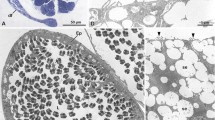Abstract
The spermatogenesis of Porifera is still relatively poorly understood. In the past, it was accepted that all species presented a primitive-type spermatozoon, lacking special structures and acrosome. Nonetheless, a very peculiar spermatogenesis resulting in a sophisticated V-shaped spermatozoon with an acrosome was found in Poecilosclerida. This finding called into question the diversity and evolution of sperm cells in Poecilosclerida and in Porifera, as a whole. Is this sophisticated spermatozoon widespread in the group? We investigated here the ultrastructure of the spermatogenesis of three different species of Poecilosclerida (Demospongiae): Iophon proximum, I. piceum, and Tedania ignis. In all three species, spermatogenesis was synchronized within the spermatic cysts. Iophon proximum and T. ignis presented elongated sperm cells, but in I. piceum, their shape was oblong. A structure resembling an acrosome was only found in T. ignis. All three species presented modified spermatozoa, as in the majority of poecilosclerids investigated so far. Therefore, we are proposing that the elongated shape (modified type) of spermatozoon is the ancestral state based in the current phylogeny of Poecilosclerida and that the V-shaped sperm is only found in Crambeidae.







Similar content being viewed by others
Abbreviations
- MNRJ:
-
Museu Nacional do Rio de Janeiro, Brazil
- RBINS:
-
Royal Belgian Institute of Natural Sciences
References
Afzelius BA (1972) Sperm morphology and fertilization biology In: Beatty RA, Gluecksohn-Waelsch S (eds) The genetics of the spermatozoon, pp 131–143
Baccetti B (1986) Evolutionary trends in sperm structure. Comp Biochem Physiol 85A:29–36. https://doi.org/10.1016/0300-9629(86)90457-3
Baccetti B, Gaino E, Sarà M (1986) A sponge with acrosome: Oscarella lobularis. J Ultrastruct Mol Struct Res 94:195–198
Bergquist P (1978) Sponges. Hutchinson, California
Boury-Esnault N, Jamieson BGM (1999) Porifera. In: Adiyodi KG, Adiyodi RG (eds) Reproductive biology of invertebrates. Oxford & IBH Publishing, New Delhi, pp 1–41
Diaz JP, Connes R (1980) Étude ultraslructurale de la spermatogenèse d’une démosponge. Biol Cell 38:225–230
Efremova SM, Ereskovsky AV, Tokina DB (1987) Gametogenesis in sponges of the family Myxillidae from the White Sea. 2. Spermatogenesis in Myxilla incrustans and Iophon piceus (Demospongiae Poecilosclerida). Ontogenez 3:263–268
Ereskovsky AV (2000) Reproduction cycles and strategies of the cold-water sponges Halisarca dujardini (Demospongiae, Halisarcida), Myxilla incrustans and Iophon piceus (Demospongiae, Poecilosclerida) from the White Sea. Biol Bull 198:77–87. https://doi.org/10.2307/1542805
Ereskovsky AV (2010) The comparative embryology of sponges. Springer, Dordrecht. https://doi.org/10.1007/978-90-481-8575-7
Ereskovsky AV (2018) Sponge reproduction. In: Skinner MK (ed), Encyclopedia of reproduction. vol. 6, Academic Press, Cambridge, pp. 485–490. https://doi.org/10.1016/B978-0-12-809633-8.20596-7
Ereskovsky AV, Willenz Ph (2007) Esperiopsis koltuni sp. nov. (Demospongiae: Poecilosclerida: Esperiopsidae), a carnivorous sponge from deep water of the Sea of Okhotsk (North Pacific). J Mar Biol Assoc UK 87:1379–1386. https://doi.org/10.1017/S0025315407058109
Franzén Å (1956) On spermiogenesis, morphology of spermatozoon and biology of fertilization among invertebrates. Zool Bidr Upp 3:355–482
Franzén A (1996) Ultrastructure of spermatozoa and spermiogenesis in the hydrozoan Cordylophora caspia with comments on structure and evolution of the sperm in the Cnidaria and the Porifera. Invertebr Reprod Dev 29:19–26. https://doi.org/10.1080/07924259.1996.9672491
Gaino E, Burlando B, Zunino L, Pansini M, Bulla P (1984) Origin of male gametes from choanocytes in Spongia officinalis (Porifera, Demospongiae). Int J Invert Rep Dev 7:83–93
Gaino E, Burlando B, Buffa P, Sarà M (1986) Ultrastructural study of spermatogenesis in Oscarella lobularis (Porifera, Demospongiae). Int J Invert Rep Dev 10:297–305.https://doi.org/10.1080/01688170.1986.10510253
Hodgson AN (1986) Invertebrate spermatozoa: structure and spermatogenesis. Arch Androl 17:105–114. https://doi.org/10.3109/01485018608990179
Kaye HR, Reiswig HM (1991) Sexual reproduction in four Caribbean commercial sponges. I. Reproductive cycles and spermatogenesis. Invertebr Repr Dev 19:1–11
L’Hernault SW (2006) Spermatogenesis. WormBook 1–14. https://doi.org/10.1895/wormbook.1.85.1
Lanna E, Klautau M (2010) Oogenesis and spermatogenesis in Paraleucilla magna (Porifera, Calcarea). Zoomorphology 129:249–261. https://doi.org/10.1007/s00435-010-0117-5
Lanna E, Cajado B, Santos da Silva C, da Hora J, Porto U, Vasconcellos V (2018) Is the Orton’s rule still valid? Tropical sponge fecundity, rather than periodicity, is modulated by temperature and other proximal cues. Hydrobiologia. https://doi.org/10.1007/s10750-018-3562-7
Maldonado M, Riesgo A (2008) Reproduction in the phylum Porifera: a synoptic overview. Treballs de la SCB 59:29–49. https://doi.org/10.2436/20.1501.02.56
Maldonado M, Riesgo A (2009) Gametogenesis, embryogenesis, and larval features of the oviparous sponge Petrosia ficiformis (Haplosclerida, Demospongiae). Mar Biol 156:2181–2197. https://doi.org/10.1007/s00227-009-1248-4
Meroz E, Ilan M (1995) Life history characteristics of a coral reef sponge. Mar Biol 124:443–451. https://doi.org/10.1007/BF00363918
Nakamura Y, Okada K, Watanabe Y (1998) The ultrastructure of spermatozoa and its ultrastructural change in the choanocyte of Sycon calcaravis Hozawa. In: Watanabe Y, Fusetani N (eds) Sponge sciences. Multidisciplinary perspectives. Springer, Tokyo
Paulus W (1989) Ultrastructural investigation of spermatogenesis in Spongilla lacustris and Ephydatia fluviatilis (Porifera, Spongillidae). Zoomorphology 109(3):123–130
Pérez-Porro AR, González J, Uriz MJ (2012) Reproductive traits explain contrasting ecological features in sponges: the sympatric poecilosclerids Hemimycale columella and Crella elegans as examples. Hydrobiologia 687:315–330. https://doi.org/10.1007/s10750-011-0919-6
Pitnick S, Hosken DJ, Birkhead TR (2009) Sperm morphological diversity. In: Birkhead TR, Hosken DJ, Pitnick S (eds) Sperm biology: an evolutionary perspective. Elsevier, Cambridge, pp 60–149
Redmond NE, Morrow CC, Thacker RW (2013) Phylogeny and systematics of Demospongiae in light of new small-subunit ribosomal DNA (18S) sequences. Integr Comp Biol 53:388–415. https://doi.org/10.1093/icb/ict078
Reiswig HM (1983) Porifera. In: Adiyodi KG, Adiyodi RG (eds) Reproductive biology of invertebrates. Oxford & IBH Publishing, New Delhi, pp 1–21
Reunov AA (2005) Problem of terminology in characteristics of spermatozoa of Metazoa. Russ J Dev Biol 36:335–351. https://doi.org/10.1007/s11174-005-0050-6
Reunov AA, Hodgson AN (1994) Ultrastructure of the spermatozoa of five species of south african bivalves (Mollusca), and an examination of early spermatogenesis. J Morphol 219:275–283. https://doi.org/10.1002/jmor.1052190307
Reynolds ES (1963) The use of lead citrate at high pH as an electron-opaque stain in electron microscopy. J Cell Biol 17:208–212. https://doi.org/10.1083/jcb.17.1.208
Riesgo A, Maldonado M (2009) An unexpectedly sophisticated, V-shaped spermatozoonin Demospongiae (Porifera): reproductive and evolutionary implications. Biol J Linn Soc 97:413–426. https://doi.org/10.1111/j.1095-8312.2009.01214.x
Riesgo A, Taylor C, Leys SP (2007a) Reproduction in a carnivorous sponge: the significance of the absence of an aquiferous system to the sponge body plan. Evol Dev 9:618–631. https://doi.org/10.1111/j.1525-142X.2007.00200.x
Riesgo A, Maldonado M, Durfort M (2007b) Dynamics of gametogenesis, embryogenesis, and larval release in a Mediterranean homosclerophorid demosponge. Mar Freshwater Res 58:398–417. https://doi.org/10.1071/MF06052
Simpson TL (1984) The cell biology of sponge. Springe, New York, p 662. https://doi.org/10.1007/978-1-4612-5214-6
Spurr AR (1969) A low-viscosity epoxy resin embedding medium for electron microscopy. J Ultra Mol Struct R 26:31–43. https://doi.org/10.1016/S0022-5320(69)90033-1
Tudge C (2009) Spermatozoal morphology and its bearing on decapod phylogeny. In: Martin JW, Crandall KA, Felder DL (eds) Decapod crustacean phylogenetics. CRC Press, Boca Raton, pp 113–132
van Soest RWM, Boury-Esnault N, Hooper JNA, Rützler K, de Voogd NJ, Alvarez B, Hajdu E, Pisera AB, Manconi R, Schönberg C, Klautau M, Picton B, Kelly M, Vacelet J, Dohrmann M, Díaz MC, Cárdenas P, Carballo JL, Ríos P, Downey R (2018) World Porifera database. http://www.marinespecies.org/porifera. Accessed 28 May 2018
Vargas S, Kelly M, Schnabel K, Mills S, Bowden D, Wörheide G (2015) Diversity in a cold hot-spot: DNA-barcoding reveals patterns of evolution among Antarctic demosponges (Class Demospongiae, Phylum Porifera). PLoS ONE 10(6):e0127573. https://doi.org/10.1371/journal.pone.0127573
White-Cooper H, Dogget K, Ellis RE (2009) The evolution of spermatogenesis. In: Birkhead TR, Hosken DJ, Pitnick S (eds) Sperm biology: an evolutionary perspective. Elsevier, Cambridge
Acknowledgements
We would like to thank the staff at the Serviços de Microscopia Eletrônica-CPqGM-Fiocruz for help with the preparation of the samples of T. ignis. The present work is part of the PhD thesis of VV presented at the PPG em Diversidade Animal of the Federal University of Bahia. PhW and AE are indebted to Profs I. Eeckhaut and P. Flammang, Laboratoire de Biologie Marine, Université de Mons for their cordial reception in the TEM facilities under their care. Profs E. Pays and D. Pérez-Morga are also thanked for welcoming us in the Centre for Microscopy and Molecular Imaging of the Université Libre de Bruxelles. J. Cillis (RBINS) gave us technical support of with the SEM. We are grateful to G. Försterra and V. Häussermann (Huinay Scientific Field Station, Chile) and the Huinay Foundation without whom collecting Iophon proximum would not have been possible. Both are further thanked, as well as R. Fitzek and S. González for the hospitality and exceptional logistic support received at the Huinay Scientific Field Station. AE is grateful to the Marine Biological Station (ERS “Belomorskaia”) of St. Petersburg State University for technical support.
Funding
EL and VV thank the Foundation for Researcher Support of the State of Bahia (FAPESB—Grant no. JCB0014/2016) and the National Council for Scientific and Technological Development (CNPq—Grant no. 477227/2013-9) for the financial assistance. This study was financed in part by the Coordenação de Aperfeiçoamento de Pessoal de Nível Superior—Brasil (CAPES)—Finance Code 001. The Belgian Federal Science Policy Office funded the work of AE at the RBINS (S&T Grant for collaboration with Oriental and Central Europe) as well as fieldwork of PhW in Chile (CALMARS I-contract EV/03/04B). This is publication Number 162 from the Huinay Scientific Field Station.
Author information
Authors and Affiliations
Corresponding author
Ethics declarations
Conflict of interest
The authors declare that they have no conflict of interest. This article does not contain any studies with human participants performed by any of the authors. Brazilian sample collections were carried out under the license of ICMBIO (#9321-1). All applicable international, national, and/or institutional guidelines for the care and use of animals were followed.
Rights and permissions
About this article
Cite this article
Vasconcellos, V., Willenz, P., Ereskovsky, A. et al. Comparative ultrastructure of the spermatogenesis of three species of Poecilosclerida (Porifera, Demospongiae). Zoomorphology 138, 1–12 (2019). https://doi.org/10.1007/s00435-018-0429-4
Received:
Revised:
Accepted:
Published:
Issue Date:
DOI: https://doi.org/10.1007/s00435-018-0429-4




